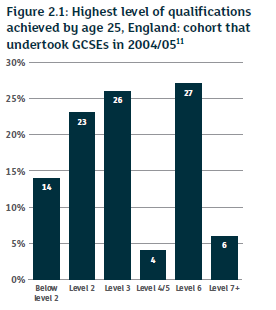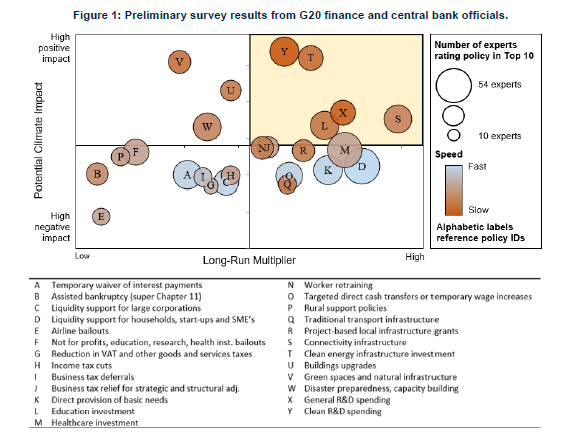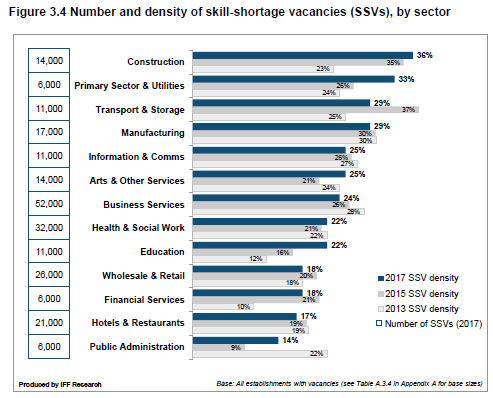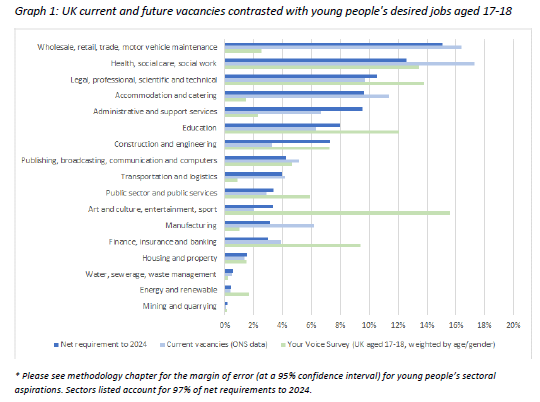I am just at the start of exploring the Green New Deal (GND), how it might work in the UK and its implications for the economy more generally. I have decided to start in an area I know a little bit about, namely education and skills, but three charts have stood out for me already in suggesting that a number of seemingly unrelated current problems may have very related solutions.
The first comes from the Augar Review into post 18 education and funding. The discussion around this when it came out in May 2019 was predominantly on the recommendations concerning increased funding for FE colleges and changes to the funding arrangements for universities. However there was a lot more to the Review than this and this chart was the most striking for me.
As you can see we hardly have any Level 4/5 as the highest level of qualification in England. What is Level 4/5? Well Level 3 means A levels, a BTEC Diploma or a craft qualification. Level 6 means a degree. In between are Levels 4 and 5. Level 5 is Foundation degrees, Higher National Diplomas (HNDs), Diplomas of Higher Education (DipHEs) and Level 4 is Higher National Certificates (HNCs), full Accounting Technician qualifications, etc.
As the Review says (my highlights in bold):
In England, only 4 per cent of 25 year-olds hold a Level 4 or Level 5 qualification as their highest level, compared to nearly 30 per cent for both Level 3 and Level 6. In contrast, in Germany, Level 4 and 5 makes up 20 per cent of all higher education enrolments.
Those few who do obtain a Level 4 or 5 award – often by a rather circuitous route – move into well-paid skilled jobs; the median annual income of someone with a Level 4 or 5 is around £2,000 higher than someone with a Level 3 by the age of 26 and comparable to the earnings of some graduates. Similarly…Level 3 apprenticeships in the skilled trades and engineering are very highly valued by employers – indeed in the latter case, for men at age 28, more than some Level 6 degrees. However…apprenticeship in England has in recent years been concentrated at lower levels (typically Level 2) than is common in the rest of Europe. Skill shortages in contrast are most evident at Levels 3 and above.
Employers have dealt with some skills shortages (for example in construction) by hiring recent immigrants with the relevant skills. They have also responded to the lack of Level 4 or 5 qualified applicants by taking on graduates as technicians, although without the relevant practical training graduates are often actually under-skilled for such roles and tend to leave quickly.
England’s education and training system currently stands in the way of taking on technician apprentices in emerging and small sectors. With no central mechanism for ensuring coverage, some employers have told us that it is often hard to identify colleges or other training providers willing to provide the necessary education and training. Providers will only do so if they are assured of a critical mass of apprentices, since otherwise the training is financially non-viable – especially if it requires expensive equipment.
The second chart or diagram comes from the paper called A net-zero emissions economic recovery from COVID-19 from the Oxford Smith School. This looks at the potential impact on reducing carbon emissions on the vertical axis and the long run multiplier (ie the increase in national income as a result of a stimulus to the economy). The obvious things to concentrate on in such a chart are those in the top right quadrant, ie high impact both environmentally and economically. The five areas unambiguously in this quadrant are Y (Clean research and development (R&D) spending), T (Clean energy infrastructure investment – ie alternatives to fossil fuels), S (Connectivity infrastructure, particularly broadband), X (General R&D spending) and L (Education investment).
And the final chart comes from the employer skills survey 2017 from the Department for Education in August 2018 (the latest one to emerge so far). This shows the vacancies due to there being insufficient people with the appropriate skills to fill them.
This should perhaps be considered in conjunction with the following very interesting comparison between the sectors where jobs are available and those where 17-18 year old typically would prefer to work (from Disconnected: Career aspirations and jobs in the UK by Chambers et al):
And this is before the big increases in skilled technicians in skilled trades, and in both scientific and technical areas and professional and managerial areas that a GND will require, coupled with the transformation of our economy as a result of the fourth industrial revolution that appears to be anticipated, at least in part, by the 17-18 year olds answering the survey. As the 2020 Progress Report to Parliament from the Committee on Climate Change on Reducing UK Emissions from last month says:
There are clear economic, social, and environmental benefits from immediate expansion of the following measures (again, my highlights in bold):
- Investments in low-carbon and climate-resilient infrastructure.
- Support for reskilling, retraining and research for a net-zero, climate-resilient economy.
- Upgrades to our homes and other buildings ensuring they are fit for the future.
- Action to make it easy for people to walk, cycle, and work remotely.
- Tree planting, peatland restoration, green spaces and other green infrastructure.
Three different problems, all with a major part of their solution in the reconfiguration of our further and higher education systems to skill and reskill, train and retrain, the generations we are relying on to secure all our futures. It looks like a good place to start!




